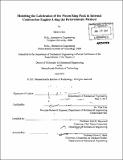Modeling the lubrication of the piston ring pack in internal combustion engines using the deterministic method
Author(s)
Chen, Haijie
DownloadFull printable version (15.78Mb)
Other Contributors
Massachusetts Institute of Technology. Dept. of Mechanical Engineering.
Advisor
Tian Tian.
Terms of use
Metadata
Show full item recordAbstract
Piston ring packs are used in internal combustion engines to seal both the high pressure gas in the combustion chamber and the lubricant oil in the crank case. The interaction between the piston ring pack and the cylinder bore contributes substantially to the total friction power loss for IC engines. The aim of this thesis work is to advance the understanding of the ring liner lubrication through numerical modeling. A twin-land oil control ring lubrication model and a top two-ring lubrication model are developed based on a deterministic approach. The models take into consideration the effect of both the liner finish micro geometry and the ring face macro profile. The liner finish effect is evaluated on a 3D deterministically measured liner finish patch, with fully-flooded oil supply condition to the oil control rings and starved oil supply condition to the top two rings. Correlations based on deterministic calculations and proper scaling are developed to connect the average hydrodynamic pressure and friction to the critical geometrical parameters and operating parameters so that cycle evaluation of the ring lubrication can be performed in an efficient manner. The models can be used for ring pack friction prediction, and ring pack/liner design optimization based on the trade-off of friction power loss and oil consumption. To provide further insights to the effect of liner finish, a wear model is then developed to simulate the liner surface geometry evolution during the break-in/wear process. The model is based on the idea of simulated repetitive grinding on the plateau part of the liner finish using a random grinder. The model successfully captures the statistic topological features of the worn liner roughness. Combining the piston ring pack model and the liner finish wear model, one can potentially predict the long term ring pack friction loss. Finally the thesis covers the experimental validation of the twin-land oil control ring model using floating liner engine friction measurements. The modeled ring friction is compared with the experimental measurement under different ring designs and liner finishes. The result shows that the model in general successfully predicts the friction force of the twin-land oil control ring/liner pair.
Description
Thesis (Ph. D.)--Massachusetts Institute of Technology, Dept. of Mechanical Engineering, 2011. Cataloged from PDF version of thesis. Includes bibliographical references (p. 131-133).
Date issued
2011Department
Massachusetts Institute of Technology. Department of Mechanical EngineeringPublisher
Massachusetts Institute of Technology
Keywords
Mechanical Engineering.